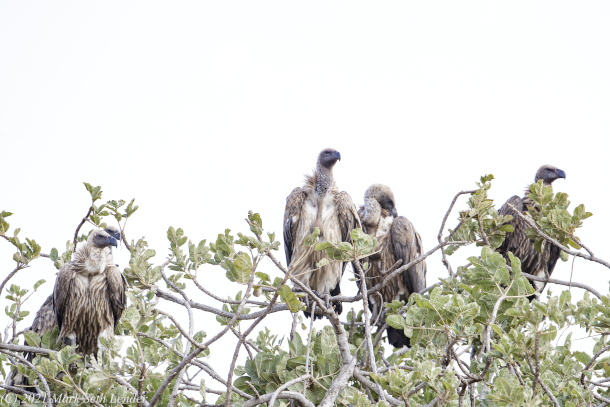Field Note: Vultures in Love
Published: October 29, 2021
By Mark Seth Lender

Vultures preen each other (Photo: (c) Mark Seth Lender)
Living on Earth's Explorer-in-Residence Mark Seth Lender comments on how vultures are typically under appreciated, and their unique kind of mutual grooming he observed in Kenya.
Vultures are a bird of least sympathy. Our animus an extension of our aversion to death despite that it is both fact and necessity; life lives on life and there is no way around it. The vulture per se we find frankly ugly. The hairless head especially disturbing. Our aesthetic prefers fur (or feathers) which we identify as analogues of features in ourselves. The toupee even when it is obviously a toupee and of no color that occurs in nature, even though an artifact of vanity and an object of ridicule, is still preferable to no hair at all. The same with vultures, their bald aspect works against them. But not as much as the living metaphor they have become.
Someone is a Vulture if they are -
- Opportunistic
- Unethical
- Waiting on a relative to die
- Not Nice
Above all it is how vultures make their living which repels. Though there is nothing to fear from them as long as you are still breathing, that salient fact tends to recede when you see them in action.
On the Zambezi two days’ paddle past Namatusi Island, there was a narrow strip of sand tucked inconspicuously into the base of a low cliff. A dead adult hippopotamus had washed ashore there and the white-backed vultures were already in full possession, all but covering the corpse. I do not recall any odor but I certainly remember the way it looked. More than anything I remember how it sounded. The vultures, their rasping laugh, their cries, their wings slapping... An Hieronymus Bosch animated in the flesh.
White-backed vultures are social. They roost together and despite their rancor when on carrion they do signal each other when they spot a dead animal. Their habit of circling is that signal and a very obvious one. It may be no more than an artifact of the way food is found and that the finding is impossible to conceal. It forces an inherent communality. And an inherent good. Without vultures the environment rapidly deteriorates into a land of remnants and corpses.
Vultures, all kinds, are intelligent and interesting but they are not exactly cuddly. It was a surprise of major proportions to see two of them all alone and in such an affectionate display. And, an incredible piece of luck.

White-backed vultures (Photo: (c) Mark Seth Lender)
Here’s what they were doing:
Termites inject formic acid when they bite, which is toxic to invading members of their own species and presumably insect predators come to do them harm. The vultures were taking advantage of that toxicity, rubbing formic acid from the crushed termites between and at the base of their feathers to discourage parasites. “Anting,” as it is called is practiced by many species of birds and while not particularly common is not that unusual. But this was mutual anting – by which I mean combination of what is called allopreening (mutual grooming, which has also been observed in white-backed vultures) with anting.
Back to Mark Seth Lender Field Notes
Links
Living on Earth wants to hear from you!
Living on Earth
62 Calef Highway, Suite 212
Lee, NH 03861
Telephone: 617-287-4121
E-mail: comments@loe.org
Newsletter [Click here]
Donate to Living on Earth!
Living on Earth is an independent media program and relies entirely on contributions from listeners and institutions supporting public service. Please donate now to preserve an independent environmental voice.
NewsletterLiving on Earth offers a weekly delivery of the show's rundown to your mailbox. Sign up for our newsletter today!
 Sailors For The Sea: Be the change you want to sea.
Sailors For The Sea: Be the change you want to sea.
 The Grantham Foundation for the Protection of the Environment: Committed to protecting and improving the health of the global environment.
The Grantham Foundation for the Protection of the Environment: Committed to protecting and improving the health of the global environment.
 Contribute to Living on Earth and receive, as our gift to you, an archival print of one of Mark Seth Lender's extraordinary wildlife photographs. Follow the link to see Mark's current collection of photographs.
Contribute to Living on Earth and receive, as our gift to you, an archival print of one of Mark Seth Lender's extraordinary wildlife photographs. Follow the link to see Mark's current collection of photographs.
 Buy a signed copy of Mark Seth Lender's book Smeagull the Seagull & support Living on Earth
Buy a signed copy of Mark Seth Lender's book Smeagull the Seagull & support Living on Earth

